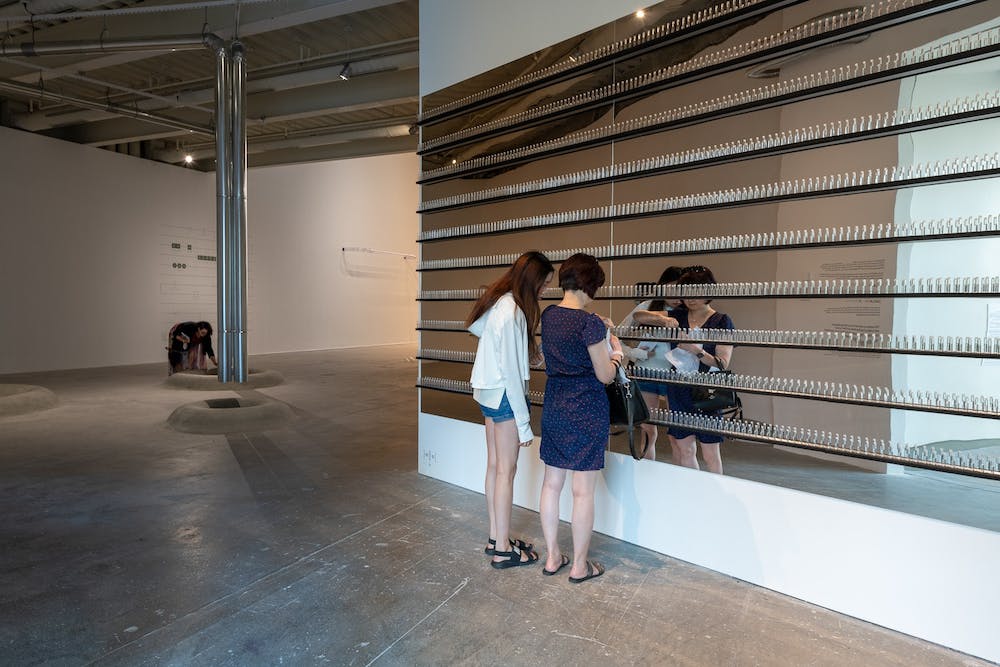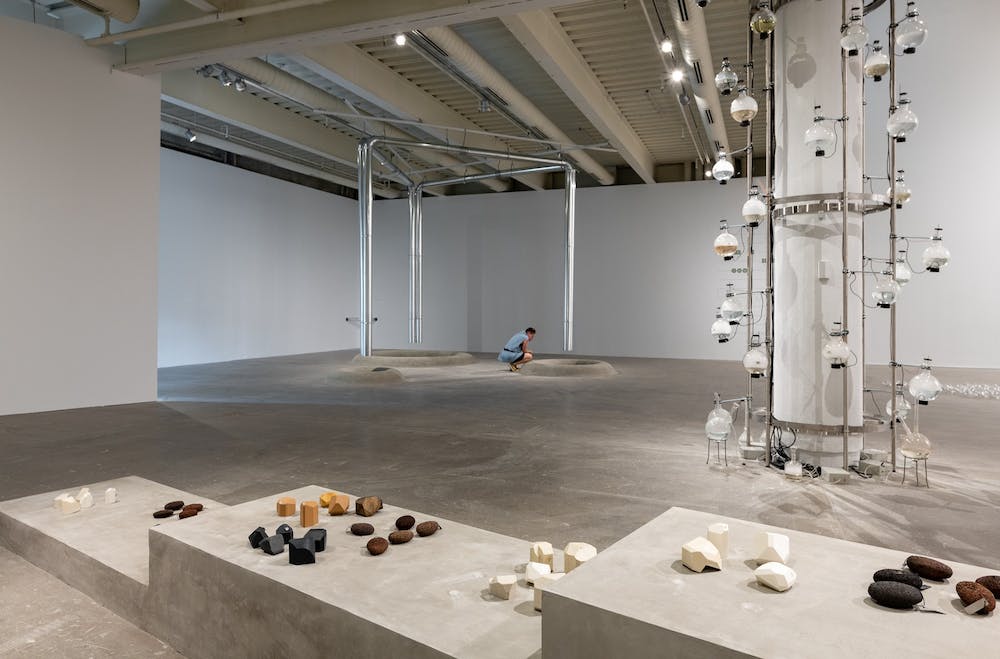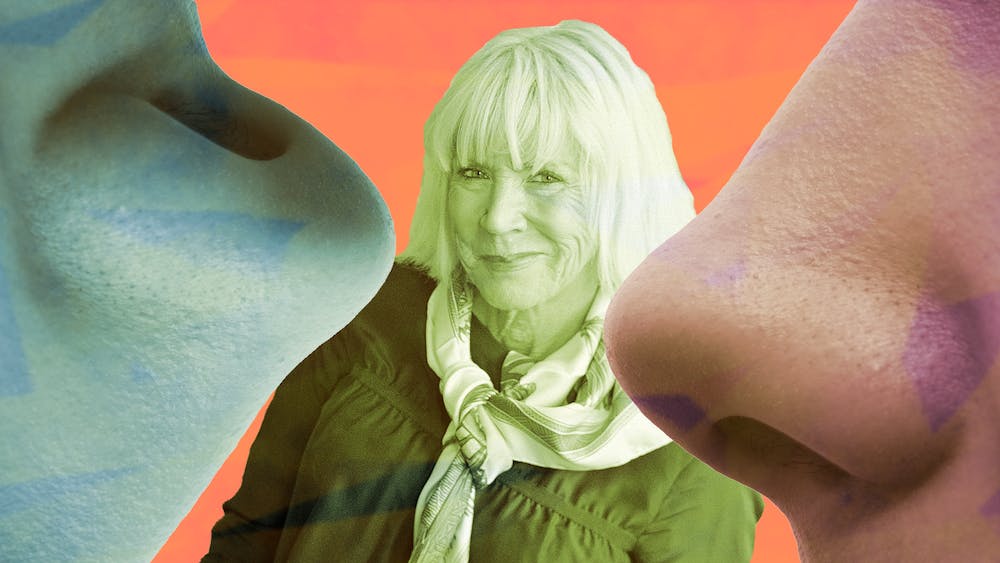Sissel Tolaas wants you to smell fear. Her exhibition RE__________, newly opened at the ICA, offers a sprawling tour of our shared smellscape; from sandy beaches to dollar bills, the Norwegian chemist–turned–artist has set out to capture the smells—both foul and fragrant—of daily life.
Viewers new to Tolaas’ work shouldn’t expect any help navigating the exhibition. RE__________ sees the artist eschew conventional museum labels in favor of a choose–your–own adventure turn through the gallery. One can never be sure what to expect—a pleasant, fruity smell might give way to the stench of a locker room.

ICA Curator Zoë Ryan describes the exhibition as one of the ICA’s “most experimental” to date—a word that’s overused in conversations about contemporary artists, but wonderfully apt here. The experiment, to borrow from Claude Bernard, consists of forced observation. Nothing could be more fitting to RE__________, which invites us to sit courtside to Tolaas’ many, thrilling transgressions—utterly transfixed.
The 20 installations comprising this exhibition (“situations,” as Tolaas calls them) tackle issues from climate change to economic inequality. But to hear the artist herself speak about the show is to move from the podium to the playground. RE_______ turns away from lofty conceptual art in favor of a personal conversation with the past.

With her platinum–blond Cleopatra bob and firm gaze, Tolaas is the picture of Nordic cool—a façade that vanishes as soon as she starts to speak. Within five minutes of her guided tour, Tolaas playfully rails against an all–American fixture: “I hear ambient noise all over town. Not cars, not pollution—air conditioning!” Her exasperation, comic as it seems, is unsurprising for an artist whose medium is air.
And while Tolaas hesitates to impose herself on the viewer, her spirited tour of the exhibition is nothing short of a joyride. As she guides a dozen journalists and staff through the gallery, she leans against the walls, lounges on the concrete floor, or toys with the objects on display.
Throughout, she delivers commentary by way of sudden, airy gestures—one hand shoots out into the air while the other twiddles her microphone. But Tolaas’ playful demeanor is not entirely unexpected. In fact, she has a track record of outré stunts.

For the London Olympics, she made a batch of Limburger cheese using bacteria from David Beckham’s soccer cleats. Another time, she showed up to a cocktail party decked in the smell of male sweat. She spent the evening observing the other guests’ reactions, which ranged from disgust to morbid fascination. Tolaas brings the same irreverence to the ICA—and, as expected for an exhibition based on smells, some situations are tough to stomach.
One installation, “Fear 22/22,” consists of a series of panels, each painted to mimic the smell of a man’s body odor. To create the installation, Tolaas took sweat samples from twenty men with severe social phobias in the midst of a panic attack. She then replicated the chemical formula in a liquid that can be applied to any flat surface: fear in a bottle.
In practice, “Fear 22/22” works much like a scratch-and-sniff. You rub the surface to activate the smell, plaster and paint standing in for human skin. Some panels were not entirely unpleasant, bringing to mind musky colognes. Others, reeking of sharp cheese or sour armpits, made me wince. Tolaas conceives of this situation as a way to approach the other—as viewers rub and sniff the wall, these anxious men overcome their greatest fear: contact with another human body.
This approach is typical of the entire show, which is built on immediacy. Simulating human connection is certainly no easy feat in the boxy, Santos–designed ICA building. But Tolaas does it all the same, striking a careful balance between order and intimacy; even as countless devices and humming machines clutter the gallery, the human touch is given precedence.
Between heaps of rubber wires and futuristic silver surfaces, the air is heavy with familiar scents.

Take El_AI, a long bench where various objects are arranged, “nano–embedded with smells from people’s stories, lives and rituals.” The smell of barbecued meat mixes with soap, freshly–sliced citruses and body odors. In another situation, by way of the compound vanillin, we encounter the primordial smell of mother’s milk.
But for all her panache, even Tolaas tiptoes around the pandemic. In a perfectly inoffensive and thus unremarkable installation, Tolaas has bottled her breath over 365 days of the pandemic. The display is dull next to RE________’s countless olfactory delights—too vain for us to see ourselves, too banal to truly move us. After all, the real meat of COVID suffering goes far beyond the monotony of self–confinement.

It’s hard to imagine the gutsy Tolaas flinching at any subject. So is this one simply too fresh, with too many of us still reeling over loved ones lost? Or maybe for the artist whose “nose is more advanced than my eyes,” COVID is simply too close for comfort. It’s easy to imagine the permanent loss of smell, one of an ever–multiplying list of COVID symptoms, as a prospect on par with dismemberment.
Regardless, when we finally make sense of COVID, we will need the artist—whose task it is to fathom the unfathomable. How everyday interactions came to a standstill. How bumbling leadership led to unnecessary deaths. How our loved ones—with all their smiles and speech and smells—were simply tallied in the end. We need art to grasp this tragedy. And Tolaas, with her compassion and irreverence, is plainly up to the task.
She’s certainly proven herself dealing with that other, ongoing tragedy: the changing climate. On the second floor, a group of fans are positioned against translucent floor–to–ceiling curtains. Synchronized to real–time ocean currents in the Nordic sea, the fans soldier on at all hours. Here, there is the expected smell of saltwater—but also the tar–like stench of pollution.

At the risk of sounding trite, much of RE_______ is about the human body’s innate rhythm—the repeated movement of air inside and out, the 24,000 breaths that punctuate the course of a day. But in this final installation, Tolaas forces us to zoom out and consider the world beyond our control.
Though we think of time in terms of our species’ activity, dividing natural history into pre- and post–human, nature has its own clock. It is indifferent both to our existence and our imminent demise.
On the way out, I nab Tolaas for a parting word. I ask about her work with International Flavors and Fragrances—a multinational chemical company that produces scents for perfumes, cleaning products, and processed foods. (Their clients include Prada, Calvin Klein, and Nestlé.) Her work is in part a reaction against corporate culture—the endless, inflated bureaucracy; the concentration of knowledge into the hands of a privileged few.
Tolaas wants, above all, to free sensory experience from elite control and social taboo. In her world, “There are no good or bad smells. It is only thinking that makes it so.” She reminds us to reorient our senses to unexpected possibilities—and to look at the familiar in a new register. Which brings us back to the intimacy underlying Tolaas’ work: the scent of a cherished meal, a childhood bedroom, a lover’s skin. Life’s quiet, constant brilliance.
RE__________ is on display at the ICA, 118 S 36th St, Philadelphia, from 09.16.22 to 12.30.22.
Source: The Nose Knows













